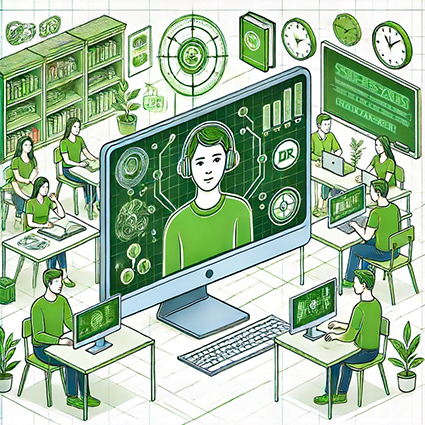Research
Our Research
At LET, we leverage learning logs and analytics to improve education based on real classroom data.
Our approach emphasizes seamless, personalized learning and evidence-based teaching.

Themes
Visualization of Learning Logs
Analyze learning logs to improve the quality of teaching and learning.
Why Visualize?
Learning logs record data such as which materials were read, where learners spent time, and what they highlighted or questioned.
Making the learning process visible enables learners to reflect and teachers to optimize instruction.
Main Logs Captured
| Type of Log | Examples |
|---|---|
| Browsing History | Which materials were opened, when, and time spent per page |
| Highlights & Notes | Highlighted text and written comments |
| Quiz Records | Responses, accuracy rates, and retry attempts |
| Revisit Logs | Frequency of accessing specific pages or materials |
Benefits for Teachers
- Identify where students struggle and use it to improve lessons
- Compare overall class trends with individual differences
- Support experience-based teaching with data-backed evidence
Benefits for Learners
- Visualize their own learning patterns objectively
- Use data to guide reviews and reflections
- Gain confidence by understanding their own learning style
Example Practice
Kyoto Municipal High School (English Class)
Using BookRoll, students highlighted “unclear sections” in yellow and “important parts” in red.
Teachers used LogPalette in class to instantly identify which paragraphs many students struggled with and adjusted lesson plans on the fly.
“With visualized data, I was able to adjust lesson plans in real time during class.”
— Kyoto Municipal Saikyo High School, English Teacher
Related Projects & Publications
-
[Cabinet Office] SIP Phase 2 Project (2018–2020)
https://www.let.media.kyoto-u.ac.jp/project/sip/ -
[Paper] Ogata et al. (2023). Visualizing Learning Behavior for Adaptive Teaching. LAK2023

Development of Educational Support Tools
Designing, developing, and evaluating educational tools based on learning sciences and real-world needs.
Collaborative Improvement with Teachers
Development progresses through ongoing dialogue with educators. Usability and educational effectiveness are repeatedly verified in actual classrooms and improved based on evidence.
Key Systems and Tools
Introducing representative tools born from field collaboration and empirical research:
BookRoll is a digital platform for delivering and recording interactive learning materials, enabling data-driven, personalized learning.
LogPalette is a learning analytics tool that visualizes learner interactions with materials, providing insights to both learners and educators.

Learner Modeling
Analyzing learning behaviors to provide personalized support.
Capturing Personalized Learning Behaviors
By analyzing behavioral data, we model learners’ comprehension and styles to support reflection for learners and feedback for teachers.
Applications for Teachers and Learners
- Teachers: Provide feedback tailored to students’ understanding.
- Learners: Reflect objectively on their own learning styles.
- Systems: Recommend materials or prompt review based on models.
Integration Across Themes
This technology works in conjunction with themes like “Visualization of Learning Logs” and “xAPI Infrastructure” to enable personalized educational support.

xAPI and Learning Infrastructure
Using xAPI, the international standard for learning activities, to centralize and utilize learning logs.
Why Build a Learning Infrastructure?
Learning happens across various tools and classrooms, but inconsistent logging makes data utilization challenging. By adopting xAPI, we can record, store, and share logs in a common format for teaching improvement, review, and research.
Design and Operation
We integrate tools like BookRoll and LogPalette with xAPI to store logs in an LRS (Learning Record Store) in real time. Using shared xAPI profiles across schools allows comparative analysis and personalized support.

Field Research
Collaborating with schools and educational sites to implement and evaluate tools in real classrooms.
Testing Theories in the Classroom
We engage in “field research” by implementing tools and models in actual school settings. Rather than temporary pilots, we pursue iterative improvement through continued use.
Examples of Application
- Analyze comprehension and engagement during class based on learning logs.
- Support reflection using post-class notes and comments.
- Correlate logs with term grades and participation data.
From Practice to Research
We value a cyclical approach where classroom feedback informs research and, in turn, benefits teaching practice—building sustainable foundations for data-informed education.
“I started using BookRoll notes to plan my lessons for the following week.”
Explore Our Work
Learn more about our research and activities.





